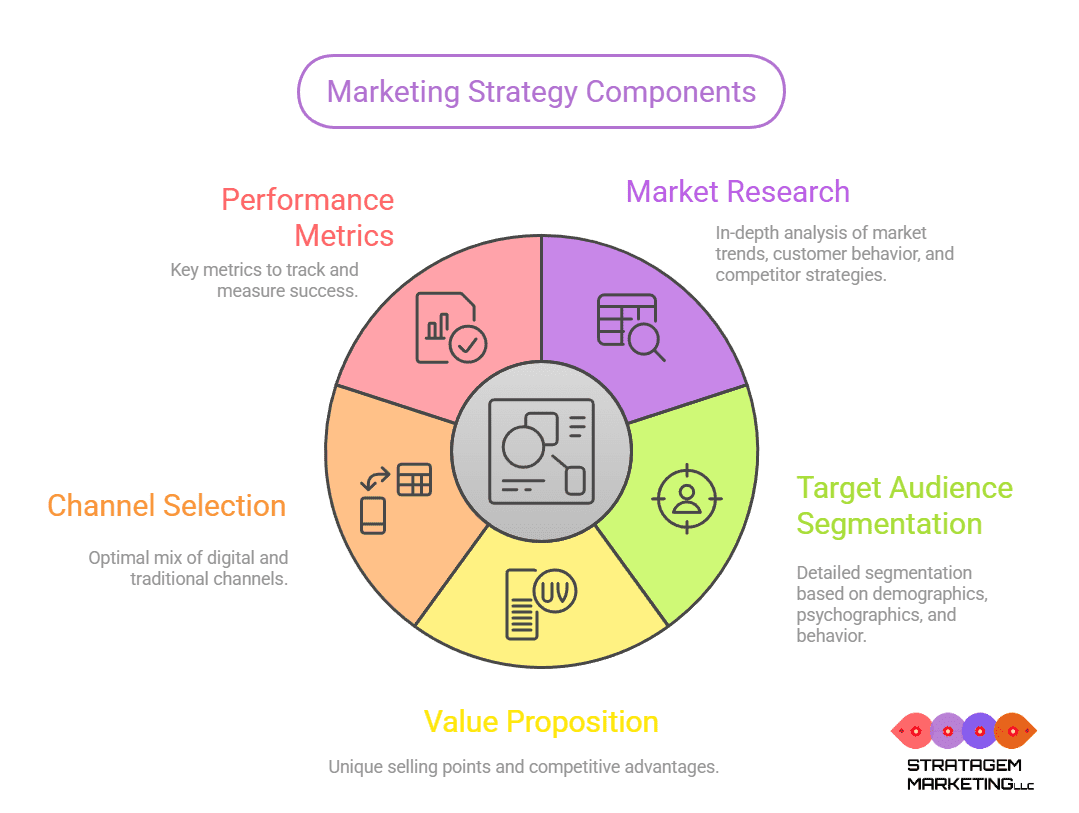Building Your Marketing Strategy: A Small Business Owner’s Guide to the Essential Components
As a small business owner, developing a marketing strategy might seem overwhelming. However, breaking it down into key components makes the process more manageable and sets your business…
4 min read
Building Your Marketing Strategy: A Small Business Owner’s Guide to the Essential Components
As a small business owner, developing a marketing strategy might seem overwhelming. However, breaking it down into key components makes the process more manageable and sets your business up for sustainable growth. This guide explores the four essential elements that form the foundation of an effective marketing strategy.
Understanding Market Analysis and Competitive Positioning
Your journey begins with a thorough understanding of your market landscape. This involves more than just knowing who your competitors are – it’s about identifying where your business fits in the broader market ecosystem.
Start by examining your target market’s size, growth potential, and key trends. Consider both demographic factors, such as age and location, and psychographic elements like values and behaviors. This research helps you identify untapped opportunities and potential challenges.
When analyzing competitors, look beyond surface-level comparisons. Evaluate their strengths and weaknesses, pricing strategies, and market positioning. What unique value do they offer? Where are they falling short? This insight helps you identify gaps in the market that your business can fill.
Your competitive positioning emerges from this analysis. It’s not about trying to be everything to everyone – it’s about finding your unique place in the market. Perhaps you offer superior customer service, innovative products, or specialized expertise. This differentiation becomes the foundation of your marketing message.
Mapping the Customer Journey
The customer journey represents every interaction between your business and your customers, from initial awareness to post-purchase engagement. Understanding this journey is crucial for delivering the right message at the right time.
Begin by documenting the typical steps your customers take before making a purchase. What triggers their initial interest? Where do they search for information? What concerns might prevent them from buying? Each stage presents an opportunity to engage and guide potential customers toward a purchase decision.
Remember that customer journeys aren’t always linear. Someone might discover your business through social media, visit your website multiple times, read reviews, and finally make a purchase after receiving an email promotion. By mapping these various pathways, you can create content and touchpoints that support customers at every stage.
Creating Brand Alignment and Messaging Framework
Your brand is more than your logo or color scheme – it’s the entire experience customers have with your business. A strong brand alignment ensures consistency across all marketing channels and customer touchpoints.
Start by defining your brand’s core elements: your mission, values, personality, and unique selling proposition. These elements should resonate with your target audience and differentiate you from competitors. They form the foundation of your messaging framework.
Your messaging framework guides all communication, ensuring consistency whether you’re writing a social media post or training customer service representatives. It should include your key messages, brand voice guidelines, and proof points that support your claims. This framework helps maintain consistency even as your marketing efforts expand.
Implementing ROI Measurement and Optimization
Marketing without measurement is like driving without a destination. Effective ROI measurement helps you understand what’s working, what isn’t, and where to invest your resources.
Begin by setting clear, measurable objectives aligned with your business goals. These might include increasing website traffic, generating leads, or improving conversion rates. Each objective should have specific metrics and timeframes for measurement.
Implement tracking systems to monitor these metrics. This might include website analytics, social media insights, or customer relationship management (CRM) software. The key is choosing tools that provide actionable data without overwhelming you with unnecessary information.
Regular analysis of these metrics helps you optimize your marketing efforts. Perhaps your email campaigns generate more leads than social media, or certain types of content consistently drive higher engagement. Use these insights to refine your strategy and allocate resources more effectively.
Moving Forward with Your Marketing Strategy
Developing a marketing strategy isn’t a one-time exercise – it’s an ongoing process of implementation, measurement, and refinement. Start with these essential components, but be prepared to adapt as your business grows and market conditions change.
Remember that you don’t need to implement everything at once. Begin with the basics, measure your results, and gradually expand your efforts. Focus on quality over quantity, and always keep your target audience’s needs at the center of your strategy.
By understanding and implementing these four essential components, you’re well on your way to developing a marketing strategy that drives sustainable growth for your small business. The key is to remain consistent, measure your results, and continuously optimize based on what you learn.
Need help getting started? Download our free marketing strategy template, designed specifically for small business owners, to begin putting these components into action for your business, or Contact Us for more help!


